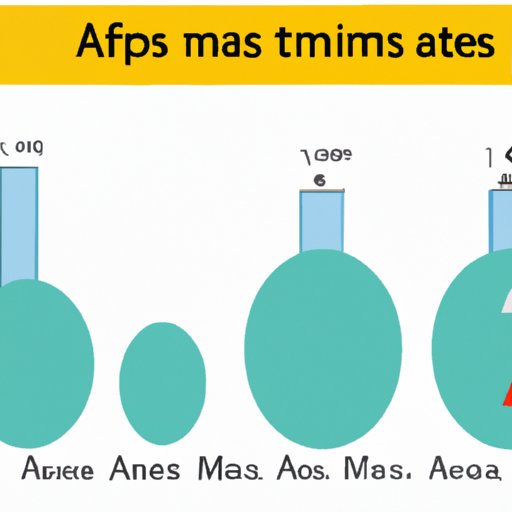
Introduction
When studying chemistry, the concept of atomic mass plays a crucial role in understanding the fundamental properties of different elements. The average atomic mass of an element is the weighted average of the masses of all its isotopes. This measurement is important because it helps scientists identify elements and predict their behavior in various chemical reactions. In this article, we provide a comprehensive guide on how to find average atomic mass.
Step-by-Step Guide
The process for finding average atomic mass is simple but requires a few calculations. First, you need to determine the percentage abundance of each isotope of the element. This percentage reflects the amount of each isotope found in nature. Next, you need to find the atomic mass of each isotope of the element. Finally, multiply the atomic mass of each isotope by its percentage abundance, sum up the results and divide by 100. The resulting value will be the average atomic mass of the element.
To better understand this process, let us use the example of calculating the average atomic mass of carbon:
- Determine the percentage abundance of each isotope of carbon
- Carbon-12: 98.9%
- Carbon-13: 1.1%
- Carbon-14: <0.1%
- Find the atomic mass of each isotope of carbon
- Carbon-12: 12 amu
- Carbon-13: 13.00335 amu
- Carbon-14: 14.00324 amu
- Multiply the atomic mass of each isotope by its percentage abundance, sum up the results and divide by 100
- (12 amu x 98.9%) + (13.00335 amu x 1.1%) + (14.00324 amu x <0.1%) = 12.011 amu
Therefore, the average atomic mass of carbon is 12.011 amu.
Real Life Examples
The calculation of average atomic mass has practical applications in various fields, including chemistry, biology, and industry. For instance, in nuclear medicine, the isotopes of different elements are used as tracers to investigate various metabolic processes. The atomic mass of these isotopes is crucial in monitoring the progress of these processes.
In chemistry, knowledge of the atomic mass of elements is essential in determining their physical and chemical properties. For example, knowledge of atomic mass is necessary in determining the stoichiometry of reactions, which is the relationship between the amounts of the reactants and products.
In the steel industry, the process of refining iron ore involves using carbon to convert it to steel. The atomic mass of carbon is an important parameter in this process because it can help the industry improve the purity of the final product.
Conceptual Understanding
Atomic mass is the mass of an atom, usually expressed in atomic mass units (amu). It is calculated by adding the mass of all protons and neutrons present in the nucleus of an atom. The atomic mass of an element is the weighted average of the mass of all its isotopes. This average is weighted by the percentage of each isotope in nature.
The atomic mass of different elements varies because isotopes of an element can have different numbers of neutrons in their nucleus. Even though isotopes of an element have the same number of protons, their different number of neutrons means they have different masses. This difference in mass is what accounts for the variation in atomic mass of different isotopes of an element.
Efficient Shortcuts
The process for finding average atomic mass can be simplified by using shortcuts. For instance, some elements have isotopes whose atomic masses are far apart, making it easier to calculate the average atomic mass. In such cases, you can approximate the average atomic mass by substituting the atomic mass of the most abundant isotope for the unknown isotope. For example, the atomic mass of Chloride is 35.5 amu, which is an average of the two isotopes (Cl-35 and Cl-37). Using the shortcut, we can substitute the atomic mass of Cl-35 in place of Cl-37 for faster calculation.
Another shortcut is the use of fractions. When the percentage abundance of an isotope is equivalent to a fraction, it helps save time in the calculations. For instance, if an isotope with a percentage abundance of 20% has an atomic mass of 10 amu, the calculation would be as follows:
(10 amu x 20/100) = 2 amu
Utilizing these shortcuts can simplify complex calculations, save time, and increase efficiency when calculating atomic mass.
Interactive Tools
Online tools and simulations are available to help you calculate average atomic mass. These tools provide a hands-on experience that allows you to practice and master the skills required to calculate atomic mass. Additionally, these tools offer additional resources and information that you can explore on your own to deepen your understanding of the concept.
Comparing Isotopes
Comparing isotopes of an element is critical in finding the average atomic mass of the element. Most elements have more than one isotope, and each isotope has its own atomic mass and percentage abundance. Therefore, identifying and comparing isotopes is vital in calculating atomic mass.
A table or chart can be utilized to summarize the common isotopes and their relative abundance for easier reference. The common isotopes of an element can also be identified from the periodic table, which displays the atomic mass of each element and its isotopes.
Conclusion
In conclusion, finding the average atomic mass of an element may seem complex, but the process is relatively straightforward when broken down into steps. Understanding the concept of atomic mass and its practical applications can also shed light on its significance in various fields.
Shortcuts and interactive tools can help make the process faster and more efficient. It is also critical to compare isotopes to identify an element’s average atomic mass accurately. Overall, exploring and experimenting with various atomic mass calculations can be incredibly rewarding and offer a deeper understanding of atomic properties and behavior.




